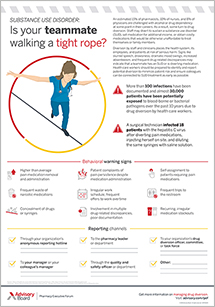Auto logout in seconds.
Continue LogoutFentanyl was the deadliest drug in the United States in 2016, according to the latest CDC data—and national security experts say the drug's lethal potency could make it an ideal weapon of mass destruction.
Upcoming webconference: Learn about Centura Health's approach to rightsizing opioid prescribing
About fentanyl
Pharmaceutical fentanyl is a powerful synthetic opioid pain reliever approved to treat severe pain. In recent years, illegal forms of the drug have circulated throughout the United States as dealers on the street work to meet the demand for opioids.
Roger Crystal—CEO of Opiant Pharmaceuticals, which is working with the U.S. Biomedical Advanced Research and Development Authority to develop an antidote to fentanyl—said, "It doesn't take much more than a half-competent chemist to be able to manufacture it. And it's cheaper to manufacture than heroin."
The drug is also extremely potent. According to Bloomberg, the equivalent of a few grains of salt can be deadly. And the latest CDC data show the drug is now the leading cause of overdose deaths.
Fentanyl leading cause of drug overdose deaths
CDC's National Center for Health Statistics on Wednesday published a new report that found fentanyl contributed to more than 18,000 overdose deaths in 2016, the most recent year for which data are available.
According to USA Today, this is the first time fentanyl has topped the list of deadliest drugs, unseating heroin, which was the leading cause of drug overdose deaths from 2012 to 2015.
Overall, the report found there were a total of 63,632 drug overdose deaths in 2016. Fentanyl was involved in nearly 29% of those cases, up from just 4% of all drug-related deaths in 2011. The CDC data showed the rate of overdose deaths from fentanyl rose by an average of 113% annually from 2013 to 2016.
After fentanyl, the report found, heroin, cocaine, and methamphetamine accounted for the highest percentages of drug-related overdose deaths. Often, multiple drugs were identified in individuals who died from an overdose. For example, the data show about 40% of people whose death records listed cocaine overdose as the primary cause of death also had fentanyl in their system.
Is fentanyl 'a weapon of mass destruction?'
Given fentanyl's potency, national security experts say it could pose yet another threat: It's an ideal candidate to be used terrorism.
The drug is extremely dangerous whether it's used as a gas, pill, or powder. According to Bloomberg, Russian forces in 2002 reportedly used a gas form of fentanyl to incapacitate armed rebels who were holding more than 800 hostages. The gas worked against the attackers, but more than 100 hostages also died in the rescue effort, Bloomberg reports.
The fatal potential of even glancing contact with fentanyl is a major reason why national security experts are becoming alarmed at the prospect of it being used to sow terror. The drug is "a significant threat to national security," according to Michael Morell, the former acting director of the CIA under former President Barack Obama, who also called the drug "a weapon of mass destruction."
Daniel Gerstein, a senior policy researcher at Rand Corporation who served as acting undersecretary in the Department of Homeland Security's Science and Technology Directorate under the Obama administration, said the drug would be most effective as a weapon in an enclosed space.
Josh Bloom, senior director of chemical and pharmaceutical research at the American Council on Science and Health, explained that the drug, if ground up into a powder form, could easily be placed on everyday objects in amounts that could be lethal if people touched them and then touched their mouths or eyes. While the drug is not usually harmful when it comes into contact with skin, researchers have found that hand sanitizer can cause the skin to absorb more of the drug.
And currently there is no effective one-dose antidote to reverse the effects of a fentanyl overdose, Bloomberg reports. Opiant is working with Barda to test a drug called nalmefene to determine whether it is effective at reversing fentanyl's effects as a nasal spray. According to Bloomberg, the company hopes to submit an application for FDA approval in 2020 (Rice, USA Today, 12/12; Baker, "Vitals," Axios, 12/13; Weixel, The Hill, 12/12; Edney, Bloomberg, 12/12).
Access our new resources on the opioid epidemic
The opioid epidemic is a complex, multi-dimensional public health problem. Use this list of helpful resources on how hospitals and health systems can play a role to treat opioid addiction and prevent further increase in opioid abuse.
Don't miss out on the latest Advisory Board insights
Create your free account to access 1 resource, including the latest research and webinars.
Want access without creating an account?
You have 1 free members-only resource remaining this month.
1 free members-only resources remaining
1 free members-only resources remaining
You've reached your limit of free insights
Become a member to access all of Advisory Board's resources, events, and experts
Never miss out on the latest innovative health care content tailored to you.
Benefits include:
You've reached your limit of free insights
Become a member to access all of Advisory Board's resources, events, and experts
Never miss out on the latest innovative health care content tailored to you.
Benefits include:
This content is available through your Curated Research partnership with Advisory Board. Click on ‘view this resource’ to read the full piece
Email ask@advisory.com to learn more
Click on ‘Become a Member’ to learn about the benefits of a Full-Access partnership with Advisory Board
Never miss out on the latest innovative health care content tailored to you.
Benefits Include:
This is for members only. Learn more.
Click on ‘Become a Member’ to learn about the benefits of a Full-Access partnership with Advisory Board
Never miss out on the latest innovative health care content tailored to you.

